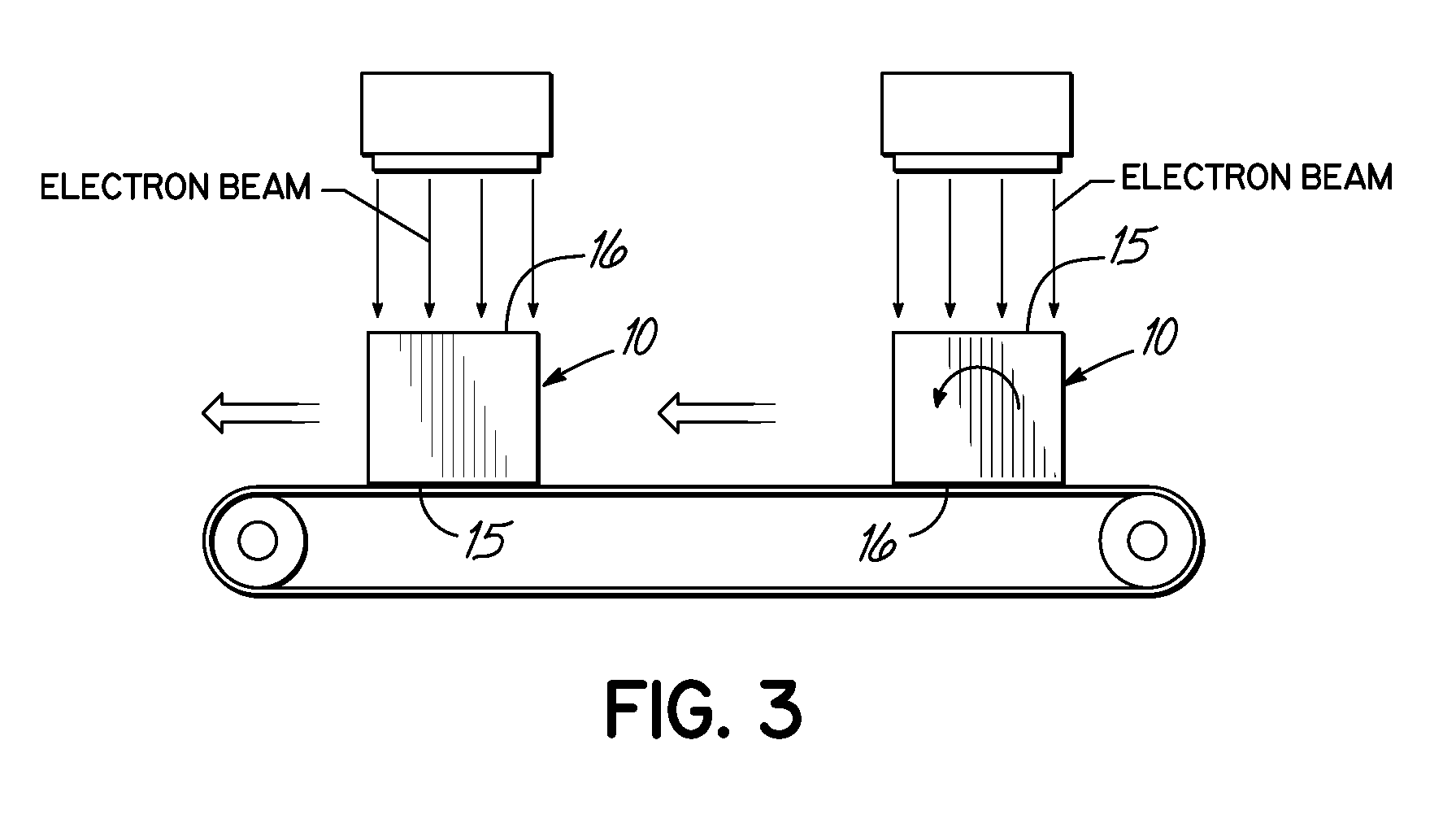Electron beam irradiation of bulk material solids
a technology of electron beam and bulk material, which is applied in the direction of packaging goods, liquid handling, applications, etc., can solve the problems of inefficiency in this process, loss of efficiency in the irradiation technique of the tray, and inability to process more efficiently
- Summary
- Abstract
- Description
- Claims
- Application Information
AI Technical Summary
Benefits of technology
Problems solved by technology
Method used
Image
Examples
example 1
[0022]An example of the application of electron beam irradiation of bulk material solids is the irradiation of ethylene vinyl acetate polymer (EVA) material. In this case the purpose of the radiation is to modify the melt flow rate property of the material from a high starting point, such as is typically produced by the high-volume reactor, into a precise, but lower melt flow rate for a particular end-product requirement. In this example the starting melt flow rate of the EVA material was 16 dg / min (ASTM D1238), and the melt flow rate of the finished product after irradiation was 0.5-1.0 dg / min. The electron beam irradiation would customarily be accomplished in one pass of a relatively thin bed of loose pellets on a horizontal conveyor. However, in this example the EVA pellets were formed into a package made entirely of thin film, such that the loose bulk material became a substantially solid rectangular block, and then the first and second opposed sides were irradiated perpendicula...
example 2
[0025]Another example of the application of electron beam irradiation of bulk material solids is the irradiation of substantially linear polypropylene material. In this case the purpose of the irradiation is to modify the molecular structure of the material by creating long-chain branching. This long-chain branching increases the melt-strength of the material, thereby extending the use of the polypropylene into more applications. The starting material had a melt strength of 2-3 cN and a melt flow rate of 0.7 dg / min (ASTM D1238). Customarily the process of increasing the melt strength of polypropylene consists of irradiation and heat-treatment of the polymer in a low oxygen atmosphere (U.S. Pat. No. 4,916,198). To accomplish this, in customary practice, the loose polypropylene pellets are processed in a thin bed of pellets under the beam and then conveyed into a fluid-bed oven to heat treat the polymer, using large and complex equipment in part due to the need to create and maintain ...
example 3
[0028]Another example of irradiating bulk material solids is in the irradiation of polytetrafluoroethylene (PTFE) flake or scrap material. In this case the purpose of the irradiation was to reduce the molecular weight of the PTFE to enable the subsequent milling of the PTFE into a fine powder. Without the irradiation of the PTFE, milling is very difficult due to the inherent high mechanical strength of the unirradiated polymer. The PTFE material can be placed in a reusable four-sided stainless steel container frame and utilizing stainless steel foil of 0.38 mm thickness on opposed faces. Using this methodology, the PTFE can be processed without creating a dust nuisance from the creation of powder during the irradiation as occurs in customary processing, for example as in U.S. Pat. No. 5,916,929 (Knobel and Minbiole). In this example, the material was processed on the first and second opposed faces, perpendicular to the beam of electrons for two-sided processing. After the irradiatio...
PUM
| Property | Measurement | Unit |
|---|---|---|
| thickness | aaaaa | aaaaa |
| thickness | aaaaa | aaaaa |
| melt flow rate | aaaaa | aaaaa |
Abstract
Description
Claims
Application Information
 Login to View More
Login to View More - R&D
- Intellectual Property
- Life Sciences
- Materials
- Tech Scout
- Unparalleled Data Quality
- Higher Quality Content
- 60% Fewer Hallucinations
Browse by: Latest US Patents, China's latest patents, Technical Efficacy Thesaurus, Application Domain, Technology Topic, Popular Technical Reports.
© 2025 PatSnap. All rights reserved.Legal|Privacy policy|Modern Slavery Act Transparency Statement|Sitemap|About US| Contact US: help@patsnap.com



